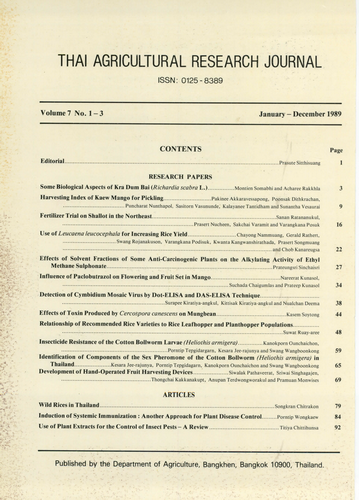Some Biological Aspects of Kra Dum Bai (Richardia scabra L.)
Abstract
Kra dum bai (Richardia scabra L.), a common weed of the sandy upland areas of the Northeast, was studied on some of its biological aspects during 1987-1988 at the Khon Kean Field Crops Research Center. The results showed that kra dum bai was an annual with a life cycle of about 120 days. The plant began to flower about 35 day after emergence and continued to produce seeds until the end of its life cycle with an average of about 3,000 seeds per plant. The seeds had a high dormancy, 87-99% depending on season. The seed dormancy was removed when begin buried under moist soil for 55 days. After the dormancy was removed, the seeds germinated readily at a depth of less than 2 cm below the soil surface and could not germinate if buried at a depth of 4 cm or more. Soil samples to a depth of 4 cm were collected in the fields
heavily infested with kra dum bai and seeds were separated using fine-meshed screen. About 6,000 – 8,000 seeds/m were founds accumulated in the top 4 – cm soil layer. These recovered seed samples had a germinability of 95% However, only 500-1,000 seeds/ m, germinated in the filed after each cultivation that disturbed the surface layer of the soil.
Downloads
Published
How to Cite
Issue
Section
License

This work is licensed under a Creative Commons Attribution-NonCommercial-NoDerivatives 4.0 International License.
Thai Agricultural Research Journal



